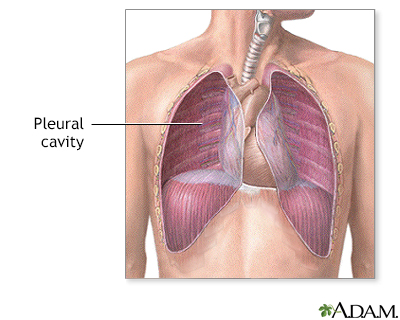Pleural fluid analysis
Pleural fluid analysis is a test that examines a sample of fluid that has collected in the pleural space. This is the space between the lining of the outside of the lungs (pleura) and the wall of the chest. When fluid collects in the pleural space, the condition is called pleural effusion.
Images

I Would Like to Learn About:
How the Test is Performed
A procedure called thoracentesis is used to get a sample of pleural fluid. Your health care provider tests the sample to look for:
- Cancerous (malignant) cells
- Other types of cells (for example blood cells)
- Levels of glucose, protein and other chemicals
- Bacteria, fungi, mycobacteria, viruses, and other germs that can cause infections
- Inflammation
How to Prepare for the Test
No special preparation is needed before the test. An ultrasound, CT scan, or chest x-ray will be performed before and after the test.
Do not cough, breathe deeply, or move during the test to avoid injury to the lung.
Tell your provider if you take medicines to thin the blood.
How the Test will Feel
For thoracentesis, you sit on the edge of a chair or bed with your head and arms resting on a table. Your provider cleans your skin around the insertion site. Numbing medicine (anesthetic) is injected into your skin.
A needle is placed through the skin and muscles of your chest wall into the pleural space. As fluid drains into a collection bottle, you may cough a bit. This is because your lung re-expands to fill the space where fluid had been. This sensation may last for a few hours after the test.
During the test, tell your provider if you have sharp chest pain or shortness of breath.
Ultrasound is often used to decide where to insert the needle and to get a better view of the fluid in your chest.
Why the Test is Performed
The test is performed to determine the cause of a pleural effusion. It is also done to relieve the shortness of breath that a large pleural effusion can cause.
Normal Results
Normally the pleural space contains less than 20 milliliters (4 teaspoons) of clear, yellowish (serous) fluid.
What Abnormal Results Mean
Abnormal results may indicate possible causes of pleural effusion, such as:
- Cancer
- Cirrhosis
- Heart failure
- Infection
- Severe malnutrition
- Very low protein (albumin) in the blood
- Trauma
- Abnormal connections between the pleural space and other organs (for example, the esophagus)
If your provider suspects an infection, a culture of the fluid is done to check for bacteria and other microbes.
The test may also be performed for hemothorax. This is a collection of blood in the pleura.
Risks
Risks of thoracentesis are:
- Collapsed lung (pneumothorax)
- Excessive loss of blood
- Fluid re-accumulation
- Infection
- Pulmonary edema
- Respiratory distress
- Cough that doesn't go away
Serious complications are uncommon.
Related Information
Pleural effusionHeart failure
Cirrhosis
References
Blok BK. Thoracentesis. In: Roberts JR, Custalow CB, Thomsen TW, eds. Roberts & Hedges' Clinical Procedures in Emergency Medicine and Acute Care. 7th ed. Philadelphia, PA: Elsevier; 2019:chap 9.
Broaddus VC, Light RW. Pleural effusion. In: Broaddus VC, Ernst JD, King TE, et al, eds. Murray and Nadel's Textbook of Respiratory Medicine. 7th ed. Philadelphia, PA: Elsevier; 2022:chap 108.
BACK TO TOPReview Date: 11/25/2023
Reviewed By: Denis Hadjiliadis, MD, MHS, Paul F. Harron Jr. Professor of Medicine, Pulmonary, Allergy, and Critical Care, Perelman School of Medicine, University of Pennsylvania, Philadelphia, PA. Also reviewed by David C. Dugdale, MD, Medical Director, Brenda Conaway, Editorial Director, and the A.D.A.M. Editorial team.

Health Content Provider
06/01/2025
|
A.D.A.M., Inc. is accredited by URAC, for Health Content Provider (www.urac.org). URAC's accreditation program is an independent audit to verify that A.D.A.M. follows rigorous standards of quality and accountability. A.D.A.M. is among the first to achieve this important distinction for online health information and services. Learn more about A.D.A.M.'s editorial policy, editorial process and privacy policy. A.D.A.M. is also a founding member of Hi-Ethics. This site complied with the HONcode standard for trustworthy health information from 1995 to 2022, after which HON (Health On the Net, a not-for-profit organization that promoted transparent and reliable health information online) was discontinued. |
The information provided herein should not be used during any medical emergency or for the diagnosis or treatment of any medical condition. A licensed medical professional should be consulted for diagnosis and treatment of any and all medical conditions. Links to other sites are provided for information only -- they do not constitute endorsements of those other sites. © 1997- 2025 A.D.A.M., a business unit of Ebix, Inc. Any duplication or distribution of the information contained herein is strictly prohibited.
